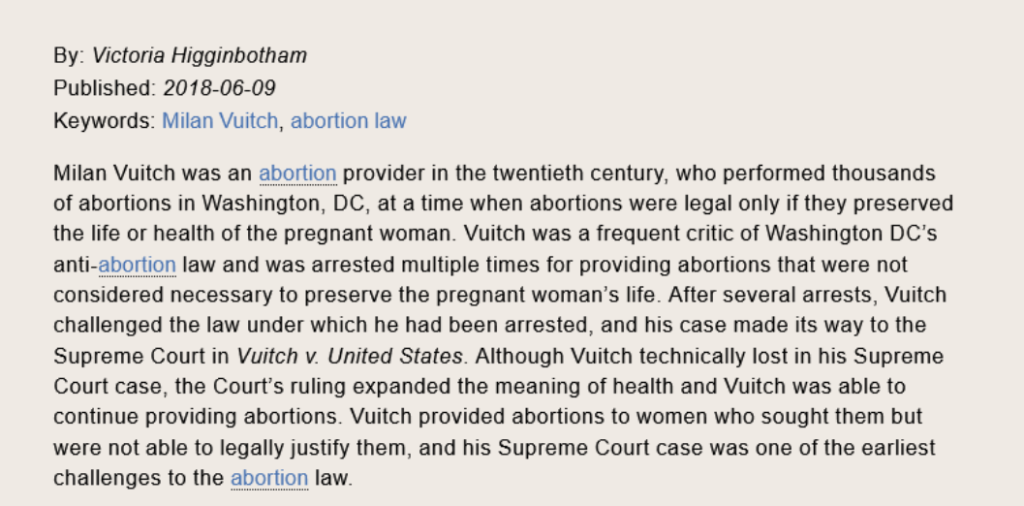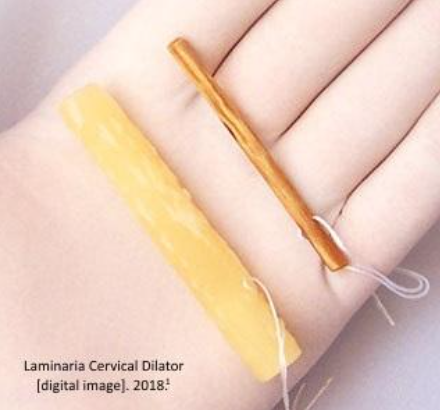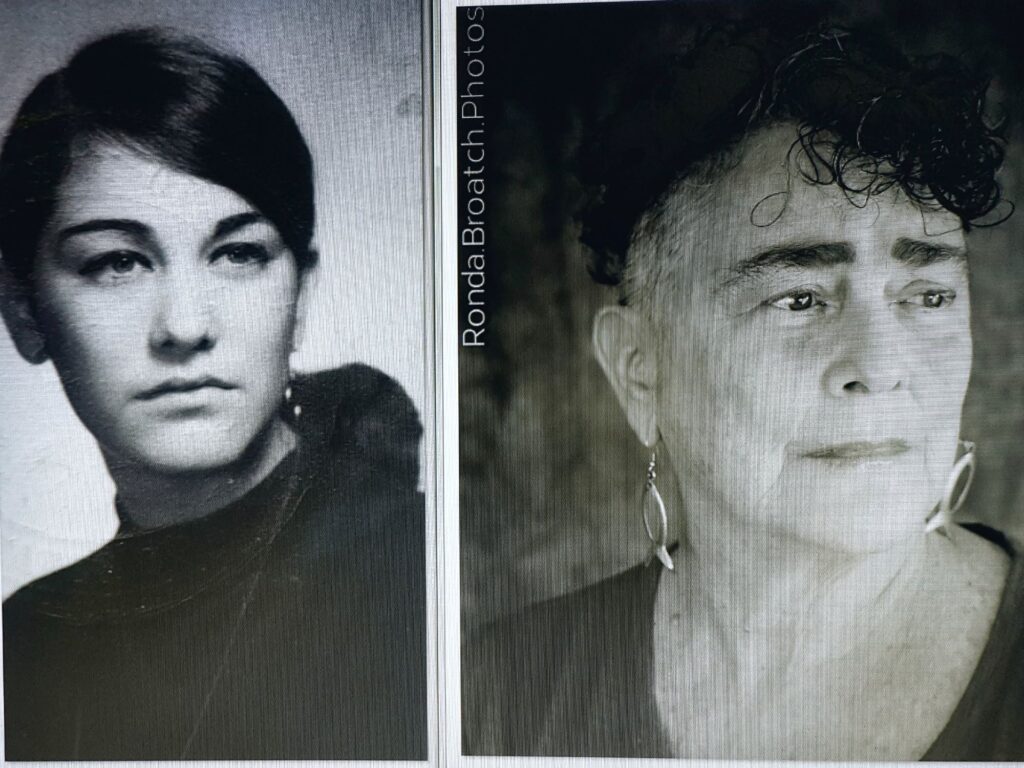Featured Essay: “Before Roe” by Risa Denenberg
Before Roe
U.S., 1968
It was an eventful year. A year that found me eighteen, on my own, and pregnant.
The news wove in and out of my personal story. US soldiers massacred men, women, and children in the village of Mai Lai as the war against the Vietnamese people dragged on. Dr. Martin Luther King, Jr., was assassinated on April 4th; fury burned in my hometown of Washington, DC, and all over the United States. Seventeen-year-old Black Panther Bobby Hutton was shot and killed by the police on April 6. Valerie Solanas shot Andy Warhol at The Factory in New York City on June 3. And Robert Kennedy was assassinated in Los Angeles on June 5. I was among the throng of youth who were teargassed by police at the Democratic National Convention in Chicago that August. There was a protest, led by feminist Robin Morgan, against the Miss America pageant on September 7 in Atlantic City, New Jersey. That year I was listening to Jimi Hendrix, The Stones, Buffalo Springfield, and The Band, and saw the movies Barbarella, Rosemary’s Baby, and 2001: A Space Odyssey.
1968 was the year I should have graduated from high school. Instead, on a sunny afternoon in May, I sat on the grass at DuPont Circle holding a sign that read, “Abortion Needed.” A few weeks before this, I was sitting in the waiting room of a medical office in Washington, DC, along with half a dozen other women, waiting my turn to see the doctor who did abortions—illegal at the time—when it was raided by cops.
I had gone to this same doctor’s office with a friend the previous year and stood by her while the doctor scraped out her uterus without anesthetic. It was painful. She squeezed my hand with one hand and held her other hand over her mouth to stifle cries. Using anesthesia and vacuum suction for early abortions wasn’t the norm until after abortion was legalized in the ’70s.
I had conceived sometime that February. It was the first time I had “gone all the way.” How should I say this? I was sexually inexperienced and chemically altered, and I wasn’t at all sure if he had ejaculated inside me. There had been no sex-ed class at school, and no one at home had talked to me about virtually anything related to sex or pregnancy—not even about having periods.
I was quietly waiting when suddenly the police charged their big bodies into the cramped waiting room. Guns weren’t drawn, but the TV-like command was given: “Nobody moves.” A woman was taken out on a stretcher. The rest of us were taken by police van to a nearby station and interrogated. Despite threats to call my parents, or to put me in a jail cell “to think about it,” I denied any knowledge that the doctor did abortions, or that I was seeking one. Again and again, I said I was waiting to see the doctor to get birth control pills. They went through my bag—an illegal search—and questioned the cash I had with me. I maintained that it was my waitress tips. Fact is, the $300 I was carrying was mostly from tips and was all in small bills. After a couple of hours of attempting to intimidate me, they turned me loose. They were looking for witnesses who would testify against the doctor, and it became clear I wasn’t going to help them. I felt enormously proud of my myself for refusing to collude with cops. I left the station feeling lighthearted, with a giddy sense of relief that I hadn’t aborted after all.
Dreaming of Green Eyes
I have green eyes. Roger, the drug-dealer who got me pregnant, had green eyes. I met him through a friend of a friend, and I knew he spelled trouble for me, but I’d somehow become enamored of those eyes. He turned me on to LSD, and we had sex while high one night in his van, although I wasn’t sure what had happened—until I missed a period.
I began dreaming of green-eyed babies. But Roger wasn’t sharing my fantasy. He threatened to pay someone to throw me down the stairs if I didn’t get an abortion. I heard that the doctor I had visited was arrested from time to time and had to close shop. Rumor was he would be back in business in a few weeks. But I couldn’t wait a few weeks and would have to rethink everything.
The Time Line … and a little research
I’ve talked about my illegal abortion many times over the years—particularly the part about the police raid—but when I decided to write about it, I was unable to recall many of the specifics. Some details remain vague in my memory, but a little research was enormously helpful, at least in tracking down details of the police raid. I found this remarkable online site, curated by researcher and writer Dr Marya McQuirter, called DC1968 Project, which led me to the details that had played such an important role in my abortion story. It confirmed the date and location, the cost, and my recollection of a woman being taken out on a stretcher. A post by McQuirter reports an event which occurred on May 2, 1968, based on archives from the Washington Free Press. It states, “After performing an abortion on a patient, Dr. Milan Vuitch, white, was arrested. The patient may have had the abortion at the private Doctors Hospital, (1816 I St, NW) where Dr. Vuitch worked.”[1]
William Blum, then an editor at the Washington Free Press, wrote this account of how a story run by the paper in 1967 led to calls by women wanting information about how to get an abortion in DC. He investigated and was one of the many individuals who participated in creating an underground referral system used to connect pregnant women with abortion services:
In September 1967, Patricia McGinnis, head of the California-based Association for Repeal of Abortion Laws, delivered a talk in the Free Press house’s living room, when she was unable to find any other venue in Washington willing to accept her. We ran a story about it in the paper. Even before the story appeared, people began calling the newspaper to find out where they might find a doctor willing to perform an abortion…. For some reason, the first call or two to the paper were referred to me at my apartment. I had begun asking around…for a lead to an abortion doctor. I quickly hit paydirt—Dr. Milan M. Vuitch. I went to see him [. . .] and he gave me permission to refer patients to him. The arrangement was that a woman would call him and, after mentioning my name, was to complain of any female-type ailment. That, a sanitary napkin, and $300 was all that she needed.[2]
I knew nothing about Dr. Vuitch at the time, other than that he performed abortions, but it turns out that he was an important crusader for changing abortion laws in Washington DC, by arguing that the then-current law—which provided for legal abortions only in the event of a threat to the life or health of the woman—was unconstitutionally vague and should allow for a broad interpretation of the woman’s mental and emotional health.
I found an article outlining Dr Vuitch’s life and the many legal challenges he faced and overcame in order to continue providing abortion care in the DC area over many years. He was arrested seventeen times and convicted once (although exonerated on appeal). The arrest on May 2, 1968, occurred on the day I was in his office. [3]

My 1968
I turned eighteen on February 25, 1968. That year found me and many of my peers protesting the war and for civil rights, experimenting with drugs, and generally disturbing our parents and school administrators. I was kicked out of high school in February of my senior year and shortly afterwards was kicked out of my parents’ home after a fight with my dad. As these events were unfolding, I had missed one period and thought I was probably pregnant. I hadn’t told anyone. At that point, I was trying to figure out what to do.
The fight happened after I spent the night out with Roger, didn’t call to let my folks know where I was, and at the time didn’t even consider that they might worry about me. It was clearly thoughtless, but I had a lot on my mind, and didn’t feel close enough to my parents to talk to them about what I was dealing with. My dad was home when I walked in about ten the next morning. We argued, and my dad slapped me in the face—something that surprised both of us—and told me to get out. I think he wasn’t sure what he might do, and it seemed safer at that moment to leave. I grabbed a few things and split. I managed, as hippies did at the time, to crash at an empty apartment near Dupont Circle in DC long enough to get an abortion and get kicked out of there. About thirteen weeks intervened between the night he kicked me out and the eventual abortion. I knew this timeline mainly in retrospect, from learning the date of the police raid and recalling size of the fetus I later passed into the toilet.
At the time, I had a job waitressing at the Hot Shoppes in Silver Spring, Maryland. Rents in DC were cheap, and I found the basement apartment where I was living, post abortion, when I invited David—my son’s father—into my life. But that came later.
The Rabbit Died
It took at least two days to get the results of a pregnancy test in 1968 (no peeing on a test strip for results in five minutes). Over-the-counter home pregnancy tests arrived in the ’70s. What we had then was the “rabbit test.” Each test required injecting an immature female rabbit with a urine sample from the woman, then dissecting the rabbit 48 hours later to examine the ovaries. If the pregnancy hormone was present in the urine, the rabbit’s ovaries would develop visible bubbles on their surface called corpora lutea—in other words, they were “popping eggs.” Rather than ask “are you pregnant?” people would ask, “did the rabbit die?” Of course, they killed the rabbit, pregnant or not. A lot of rabbits died.[4]
By the time I missed my period, figured out how and then where to get a pregnancy test, waited for the phone call with the results (positive), and failed at my first try at getting an abortion, it was early May, and that brought me to about eleven weeks into the pregnancy.
Second Round
After the raid at the doctor’s office, I wanted to continue the pregnancy. Probably I was scared to have an abortion (having seen one performed), but I also think my pregnancy hormones had kicked in. But when Roger threatened, I backed down. On the afternoon in mid-May when I sat on the grass at DuPont Circle holding a sign that said, “Need an Abortion,” people put dollar bills and small change into my lap all afternoon but no leads on finding an abortionist. I was about to give up for the day when someone thrust a phone number into my hand.
The number led me to a woman who said she could help me. Roger offered to drive me to her place on his motorcycle, which didn’t seem like the best idea to me. I never saw him again after that, but he got two other friends of mine pregnant, and one friend ended up getting arrested with him and served time in prison.
After the drug deal gone well
he bought me a bloody steak
left the waitress
a crisp one-hundred-dollar bill.How I could have used it!
I vomited all night.
I would never eat meat again.
He didn’t even pay for the abortion.From “Selfie at Seventeen,” Risa Denenberg
The next week, I borrowed a car and drove to an address somewhere in the Maryland suburbs. By then, it was late in May. In a pleasant apartment, I met a middle-aged Black woman who had me lie on my back on a towel she had placed over her bedspread. She probably worked in a hospital and had access to what she needed. She had me spread my legs wide and pushed something metallic and cold into my vagina, then forced something into my cervix, causing a brief painful sensation. She left the end of it hanging out of my vagina like a tampon string. This was my first pelvic exam. I had never seen a speculum.
Although sometimes urinary catheters were placed into the cervix to cause abortion at the time, I think what she inserted into my cervix must have been laminaria—a bundle of thin sticks of seaweed that expand with moisture, sometimes used to dilate the cervix during labor, and sometime used to start an abortion. She had asked for $400 but accepted the $350 I had brought with me. [5]

I didn’t feel much of anything that night. She told me very little about what to expect. Her only instruction was to pull the string out after twenty-four hours. For all I knew at the time, that was the abortion. I felt normal until I started cramping and bleeding in the kitchen at work the next day. I left a trail of tiny blood drops walking home from the bus along 17 th Street, to the place I was crashing at 17th and S. I spent the night in the bathtub cramping hard and bleeding heavily, drinking water from the spigot to stay hydrated, and eventually passing the fetus into the toilet. I was about thirteen-weeks pregnant, the fetus looked like a tiny pink animal, about the size of a plum. A piglet, I thought. I cried. I spent my last $10 on heroin.
Aftermath
1969 was the year that Shirley Chisholm was sworn in as the first Black woman elected to Congress; the year of the first moon landing and Woodstock; the year that PBS was launched; the year that Fred Hampton, chairman of the Illinois Black Panther party, was shot and killed by police; and the year I had my son.
About six months after the abortion, I intentionally conceived my son, who was born in November 1969. From 1975-88, I was a director of the Feminist Women’s Health Center in Tallahassee, Florida, where among other services we performed first-trimester abortions. We were harassed and threatened for years by anti-abortion protesters, and I was friends with one of the doctors—John Bayard Britton—who was assassinated by anti-abortion extremists in 1994, shot in the head while wearing a bulletproof vest. Bayard was well aware of the threat. He had given handguns to several of us to use to protect ourselves. [6]
Some years, it’s difficult to see which way the tides are turning. Progress seems to always be followed by stronger and more virulent backlash. I didn’t ever want women to have to have go back to the days of illegal abortion, but I’ve not been feeling very hopeful since the Supreme Court’s Dobbs v. Jackson Women’s Health Organization decision in June 2022. The encroaching loss of reproductive rights is emblematic of a very deep dive into repression and anti-democratic ascendancy, not only on abortion rights, but on all progressive fronts.
In no way do I regret having had an abortion or working in an abortion clinic. I’ve enjoyed a long career as a nurse practitioner and the riches of having a son and grandchildren. I will do all I can to maintain the right to reproductive freedom for their generation and beyond. If it comes down to me having to perform illegal abortions myself, I will not hesitate for a moment.
[1] Marya McQuirter, “2 May 1968 & Physician Arrested after Performing Abortion,” Dc1968 Project: 365 Stories Re Washington Dc in 1968 (blog), May 2, 2018, https://www.dc1968project.com/blog/2018/5/2/2-may-1968-physician-arrested-after-performing-abortion?rq=abortion.
[2] McQuirter, “2 May 1968 & Physician Arrested after Performing Abortion.”
[3] Higginbotham, Victoria, “Milan Vuitch (1915–1993)“. Embryo Project Encyclopedia ( 2018-06-09 ). ISSN: 1940-5030 https://hdl.handle.net/10776/13070
[4] Marc Lallanilla, “A Brief History of Pregnancy Tests,” Live Science (blog), June 4, 2013, https://www.livescience.com/37128-history-of-pregnancy-tests-ept-hcg.html.
[5] The Stevens Company Limited (2021). Laminaria Cervical Dilator 5mm Large. Retrieved June 2021 from Stevens.ca.
[6] “John Britton (Doctor),” in Wikipedia, accessed September 19, 2023, https://en.wikipedia.org/wiki/John-Britton_(doctor)
 Risa Denenberg lives on the Olympic peninsula in Washington state where she works as a nurse practitioner. She is a co-founder of Headmistress Press; curator at The Poetry Café Online; and the Reviews Editor at River Mouth Review. She has published eight collections of poetry, most recently, Rain/Dweller (
Risa Denenberg lives on the Olympic peninsula in Washington state where she works as a nurse practitioner. She is a co-founder of Headmistress Press; curator at The Poetry Café Online; and the Reviews Editor at River Mouth Review. She has published eight collections of poetry, most recently, Rain/Dweller (
